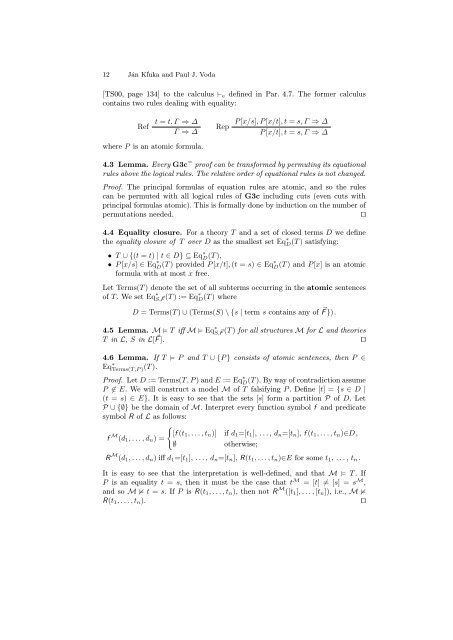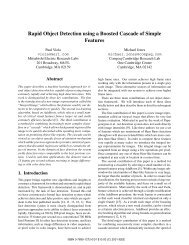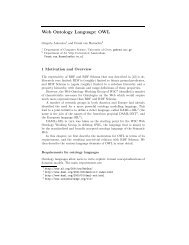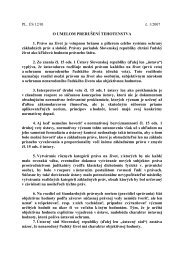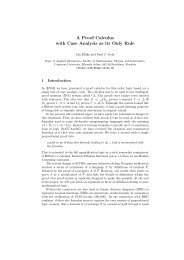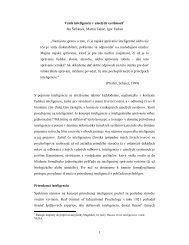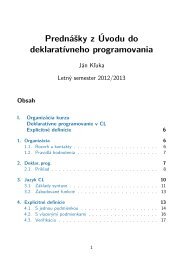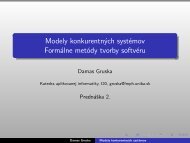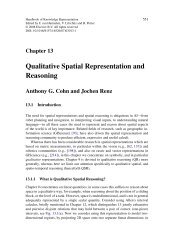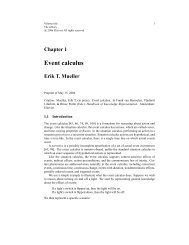12 Ján Kľuka <strong>and</strong> Paul J. Voda[TS00, page 134] to the calculus ⊢e defined in Par. 4.7. The <strong>for</strong>mer calculuscontains two rules dealing with equality:Reft = t, Γ ⇒ ∆Γ ⇒ ∆where P is an atomic <strong>for</strong>mula.RepP [x/s], P [x/t], t = s, Γ ⇒ ∆P [x/t], t = s, Γ ⇒ ∆4.3 Lemma. Every G3c = proof can be trans<strong>for</strong>med by permuting its equationalrules above the logical rules. The relative order of equational rules is not changed.Proof. The principal <strong>for</strong>mulas of equation rules are atomic, <strong>and</strong> so the rulescan be permuted with all logical rules of G3c including cuts (even cuts withprincipal <strong>for</strong>mulas atomic). This is <strong>for</strong>mally done by induction on the number ofpermutations needed.⊓⊔4.4 Equality closure. For a theory T <strong>and</strong> a set of closed terms D we definethe equality closure of T over D as the smallest set Eq ∗ D(T ) satisfying:• T ∪ {(t = t) | t ∈ D} ⊆ Eq ∗ D(T ),• P [x/s] ∈ Eq ∗ D(T ) provided P [x/t], (t = s) ∈ Eq ∗ D(T ) <strong>and</strong> P [x] is an atomic<strong>for</strong>mula with at most x free.Let Terms(T ) denote the set of all subterms occurring in the atomic sentencesof T . We set Eq ∗ S, ⃗ F (T ) := Eq ∗ D(T ) whereD = Terms(T ) ∪ (Terms(S) \ {s | term s contains any of ⃗ F }).4.5 Lemma. M T iff M Eq ∗ S, F ⃗ (T ) <strong>for</strong> all structures M <strong>for</strong> L <strong>and</strong> theoriesT in L, S in L[ F ⃗ ].⊓⊔4.6 Lemma. If T P <strong>and</strong> T ∪ {P } consists of atomic sentences, then P ∈Eq ∗ Terms(T,P )(T ).Proof. Let D := Terms(T, P ) <strong>and</strong> E := Eq ∗ D(T ). By way of contradiction assumeP ∉ E. We will construct a model M of T falsifying P . Define [t] = {s ∈ D |(t = s) ∈ E}. It is easy to see that the sets [s] <strong>for</strong>m a partition P of D. LetP ∪ {∅} be the domain of M. Interpret every function symbol f <strong>and</strong> predicatesymbol R of L as follows:{f M [f (t 1 , . . . , t n )] if d 1 =[t 1 ], . . . , d n =[t n ], f (t 1 , . . . , t n )∈D,(d 1 , . . . , d n ) =∅otherwise;R M (d 1 , . . . , d n ) iff d 1 =[t 1 ], . . . , d n =[t n ], R(t 1 , . . . , t n )∈E <strong>for</strong> some t 1 , . . . , t n .It is easy to see that the interpretation is well-defined, <strong>and</strong> that M T . IfP is an equality t = s, then it must be the case that t M = [t] ≠ [s] = s M ,<strong>and</strong> so M t = s. If P is R(t 1 , . . . , t n ), then not R M ([t 1 ], . . . , [t n ]), i.e., M R(t 1 , . . . , t n ).⊓⊔
A <strong>Simple</strong> <strong>and</strong> <strong>Practical</strong> <strong>Valuation</strong> <strong>Tree</strong> <strong>Calculus</strong> <strong>for</strong> <strong>First</strong>-<strong>Order</strong> <strong>Logic</strong> 134.7 Proofs in first-order logic with equality. We now extend the relationof q-witnessing (see Par. 3.7) to first-order logic with equality without addingany new initial properties or changing the extension cuts. The difference is thatinstead of letting ◦ witness a set Γ in antecedents of ⇒, we saturate Γ withequalities by <strong>for</strong>ming its equality closure.The seven place relation D e-witnesses T, Γ ⇒ L, F ⃗ S, ∆, in writing D ⊢eT ; Γ ⇒ L, F ⃗ S; ∆, is the least relation satisfying:• ◦ ⊢e T ; Γ ⇒ L, F ⃗ S; ∆ if (T ∩ ∆), Eq ∗ ∆, F ⃗ (Γ ) ⇒ L, F ⃗ (S ∩ Γ ), ∆ is a weakeningof an initial quantification property,• D EA[ F ⃗ ⊢e T ; Γ ⇒ L,∅ S; ∆ if D ⊢e T ; A[ F ⃗ ], Γ ⇒ L[ F ⃗ ],∅ S; ∆, <strong>and</strong> E ⊢e T ; Γ]⇒ L, F ⃗ S; A[ F ⃗ ], ∆.Note that the relation is decidable because the equality closure <strong>for</strong> finite sets isfinite.4.8 Lemma (Reduction of G3c = proofs to ⊢e trees). If there is a derivationE in G3c = of a closed sequent Γ ⇒ ∆ in a language L, then there is avaluation tree E ∗ e-witnessing Γ ⇒ L,∅ ∆. If E is cut free, then D ∗ is free cutfree.Proof. For the duration of the proof we write Γ c <strong>for</strong> the set of <strong>for</strong>mulas in Γbut with every eigen-variable y c replaced by the constant c. We write Γ a <strong>for</strong> theset of atomic <strong>for</strong>mulas in Γ . We may assume that E is in a <strong>for</strong>m guaranteed byLemma 4.3. We proceed by induction on D similar to that in Lemma 3.8:If D is a subtree of E proving in G3c = the sequent Γ ⇒ ∆ <strong>and</strong> itsimmediate ancestor in E (if any) is not obtained by an equality rule(Ref) or (Rep), then there is a valuation tree D ∗ s.t. D ∗ ⊢e Γ c ⇒ L′ ,∅ ∆ cwhere L ′ is the extension of L with Henkin constants corresponding tothe eigen-variables y c introduced on the branch leading from D to E.In the base case, D is a maximal branch consisting of at most rules (Ref) or(Rep). Let the leaf of D be Γ ′ ⇒ ∆. It must be an identity axiom <strong>and</strong> so thereis a <strong>for</strong>mula A ∈ Γ 1 ∩ ∆. We consider two cases: If A is not atomic, then wemust have A ∈ Γ , <strong>and</strong> it suffices to set D ∗ := ◦ because Eq ∗ ∆ c ,∅(Γ c ) ⇒ L ′ ,∅ ∆ cis a weakening of (Ax). If A is atomic, then we remove the non-atomic <strong>for</strong>mulasfrom all sequents in D whereby we obtain a proof D a of the sequent Γ a ⇒ ∆ awith the leaf Γ a 1 ⇒ ∆ a s.t. A ∈ Γ a 1 ∩ ∆ a . Define D := Terms(Γ c ) ∪ Terms(∆ c )<strong>and</strong>D ′ := D ∪ {t | (t = t) is principal in a (Ref) rule of D} c .By the <strong>for</strong>m of equational rules, we have Γ ac1 ⊆ Eq ∗ D ′(Γ ac ). Thus Eq ∗ D ′(Γ ac ) A c , <strong>and</strong> by Lemma 4.5 Γ ac A c . By Lemma 4.6 we then getA c ∈ Eq ∗ Terms(Γ ac ,A c )(Γ ac ) ⊆ Eq ∗ D(Γ ac ) ⊆ Eq ∗ D(Γ c ).Thus it suffices to set D ∗ := ◦ because ◦ ⊢e Γ c ⇒ L′ ,∅ ∆ c . The inductive casegoes through just as in the proof of Lemma 3.8.If E is cut free, then there are no free cuts in E ∗ .⊓⊔


